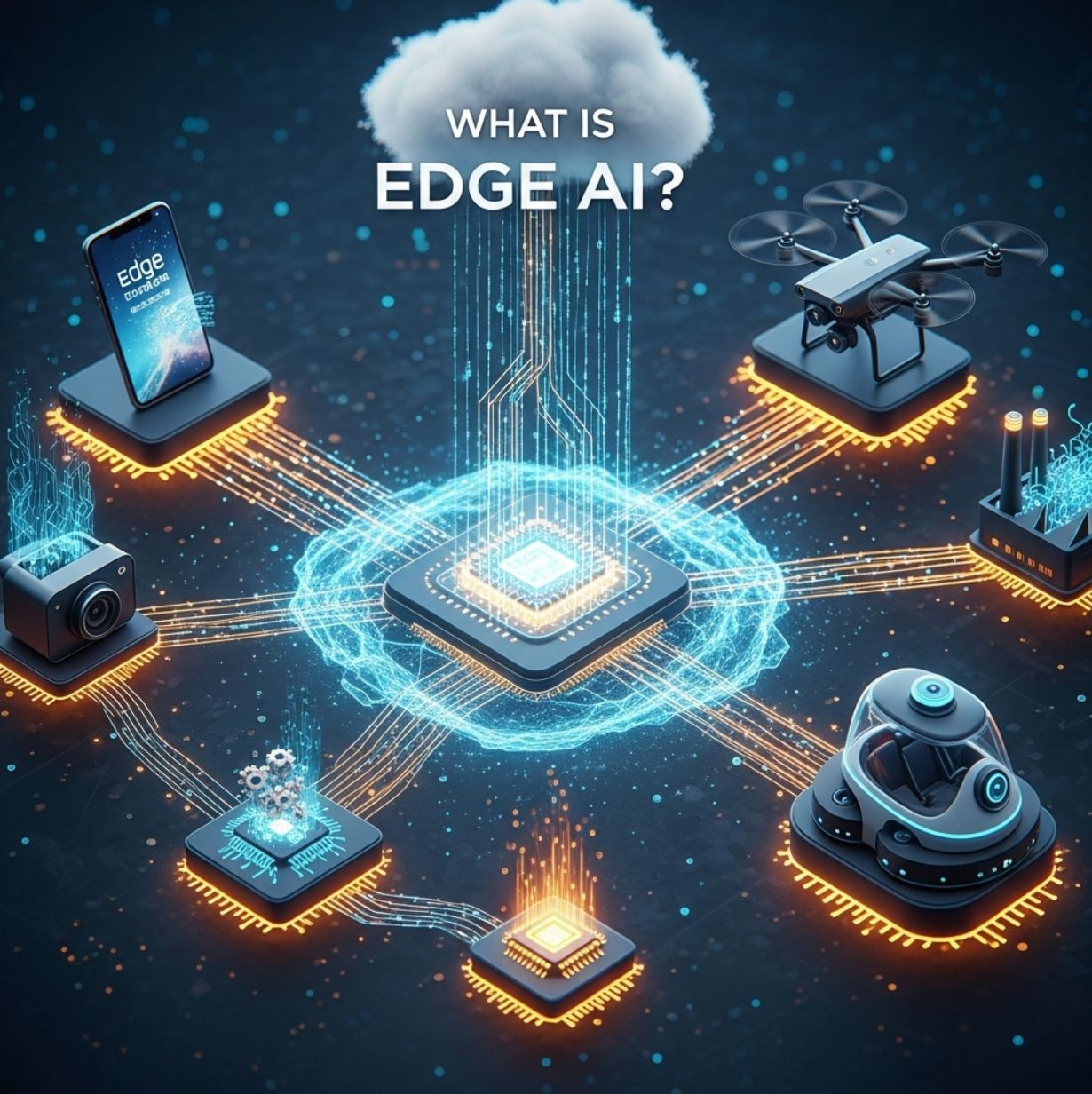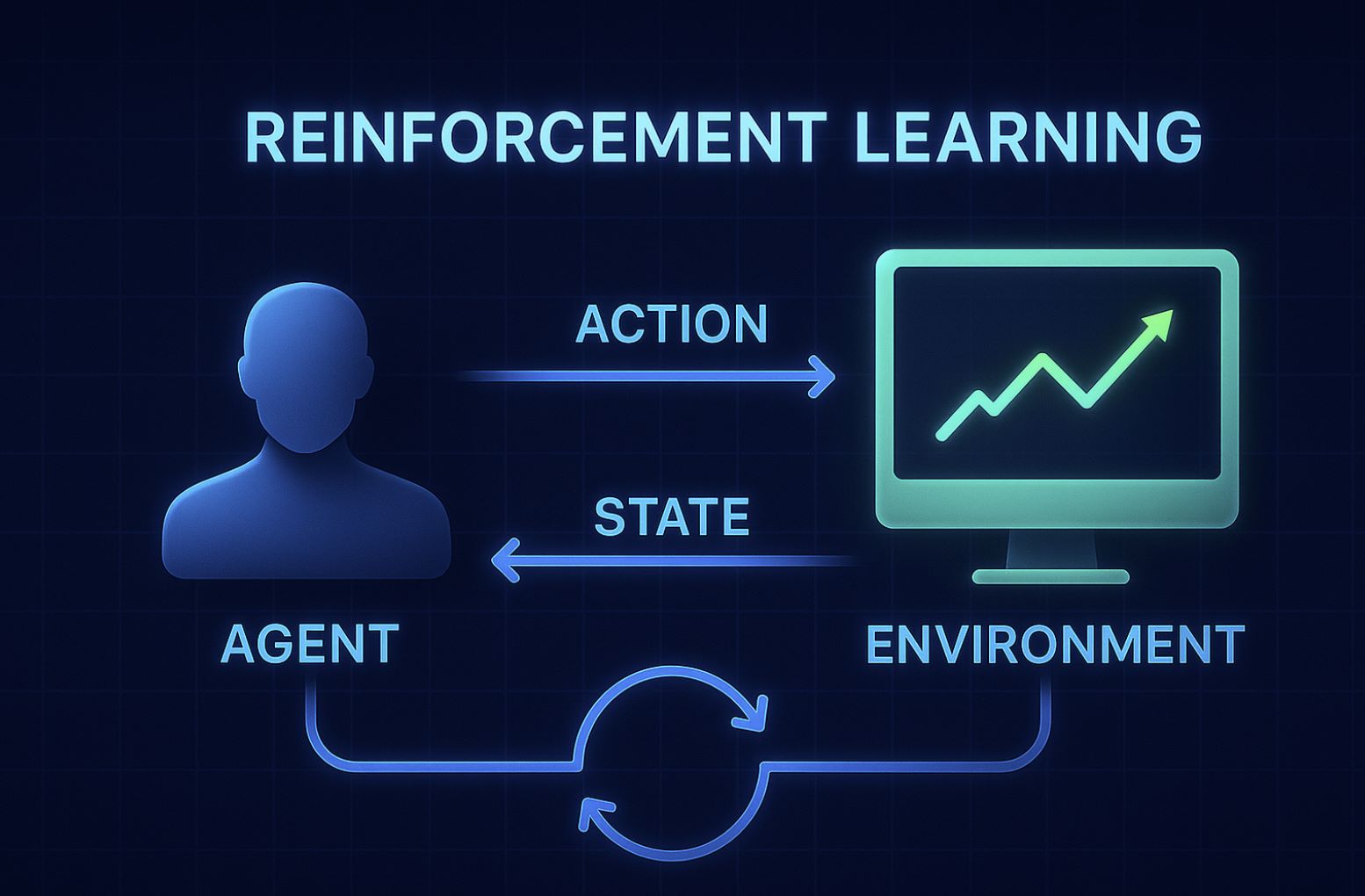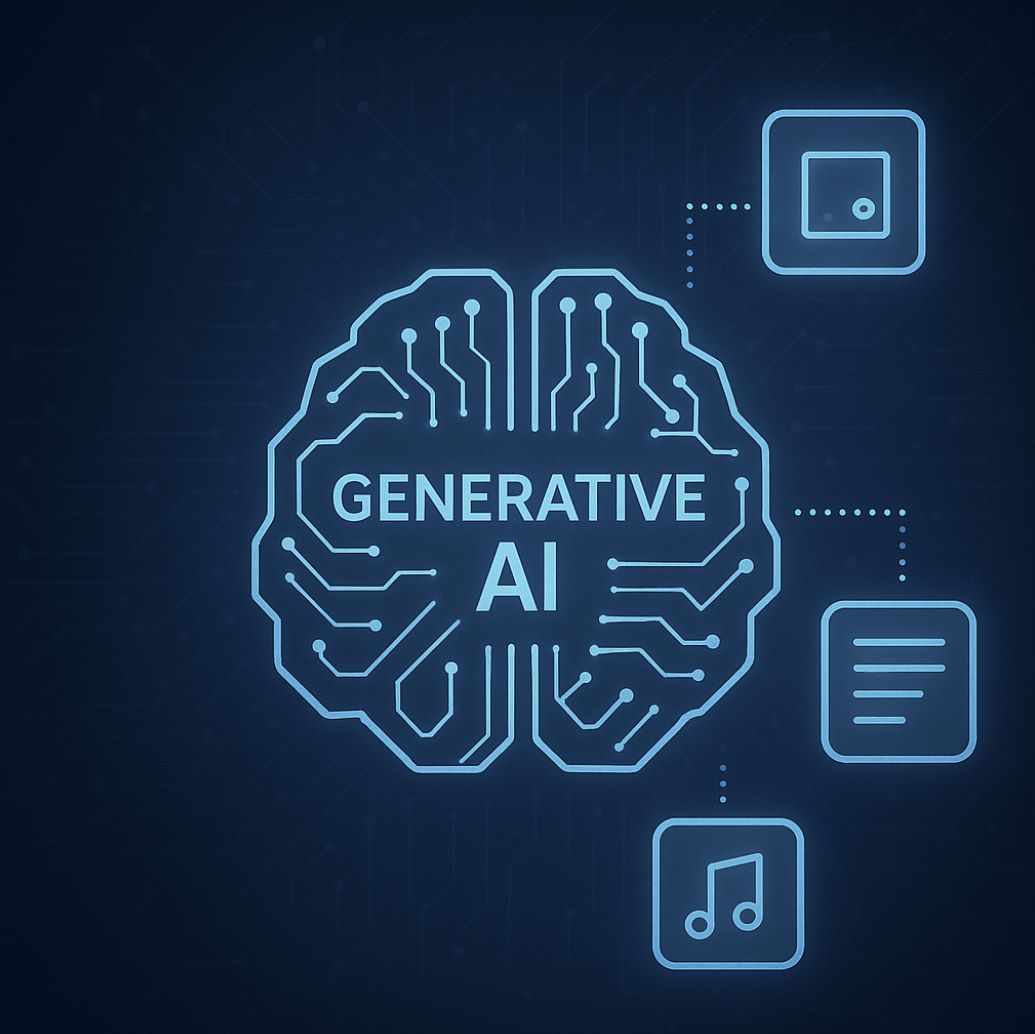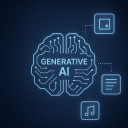Edge AI (sometimes called “AI at the edge”) means running artificial intelligence and machine-learning models on local devices (sensors, cameras, smartphones, industrial gateways, etc.) rather than in remote data centers. In other words, the “edge” of the network – where data is generated – handles the computing. This lets devices analyze data immediately as it’s collected, instead of constantly sending raw data to the cloud.
As IBM explains, Edge AI enables real-time, on-device processing without relying on a central server. For example, a camera with Edge AI can detect and classify objects on the fly, giving instant feedback. By processing data locally, Edge AI can work even with intermittent or no internet connection.
According to industry reports, this shift is happening fast: global spending on edge computing reached about $232 billion in 2024 (up 15% from 2023), largely driven by AI-powered IoT growth.
In summary, Edge AI simply brings computation closer to the data source – deploying intelligence on devices or nearby nodes, which speeds up responses and reduces the need to transmit everything to the cloud.
Edge AI vs Cloud AI: Key Differences
Unlike traditional cloud-based AI (which sends all data to centralized servers), Edge AI distributes computing among on-site hardware. The diagram above illustrates a simple edge-computing model: end devices (bottom layer) feed data to an edge server or gateway (middle layer) instead of only to the distant cloud (top layer).
In this setup, AI inference can happen on the device or the local edge node, greatly reducing communication delays.
- Latency: Edge AI minimizes lag. Because processing is local, decisions can occur in milliseconds. IBM notes that edge-based inference “provides reduced latency by processing data directly on the device,” whereas cloud AI incurs extra delay sending data to and from remote servers.
This is critical for time-sensitive tasks (e.g. avoiding a car accident or controlling a robot). - Bandwidth: Edge AI cuts network load. By analyzing or filtering data on-site, far less information must be sent upstream. IBM explains that edge systems “call for lower bandwidth” since most data stays local.
In contrast, cloud AI requires continuous high-speed connections to move raw data back and forth. This makes Edge AI more efficient and cheaper to run when networks are busy or expensive. - Privacy/Security: Edge AI can enhance privacy. Sensitive data (voice, images, health readings) can be processed and stored on-device, never transmitted to the cloud. This reduces exposure to third-party breaches.
For example, a smartphone may recognize your face locally without uploading your photo. By comparison, cloud AI often involves sending personal data to external servers, which can raise security risks. - Compute Resources: Cloud data centers have virtually limitless CPU/GPU power, allowing very large AI models. Edge devices have far less processing and storage. As IBM notes, edge units are “limited by the device’s size constraints”.
Therefore, Edge AI often uses optimized or smaller models. In practice, training heavy models usually still occurs in the cloud, and only compact, quantized models are deployed to edge devices. - Reliability: By reducing dependence on continuous connectivity, Edge AI can keep critical functions running even if the network is down. A drone, for example, can navigate using on-board AI when it loses signal to the base.
In short, edge and cloud AI complement each other. Cloud servers handle heavy-duty training, archiving and large-batch analytics, while Edge AI handles real-time inference and quick decisions close to the data.
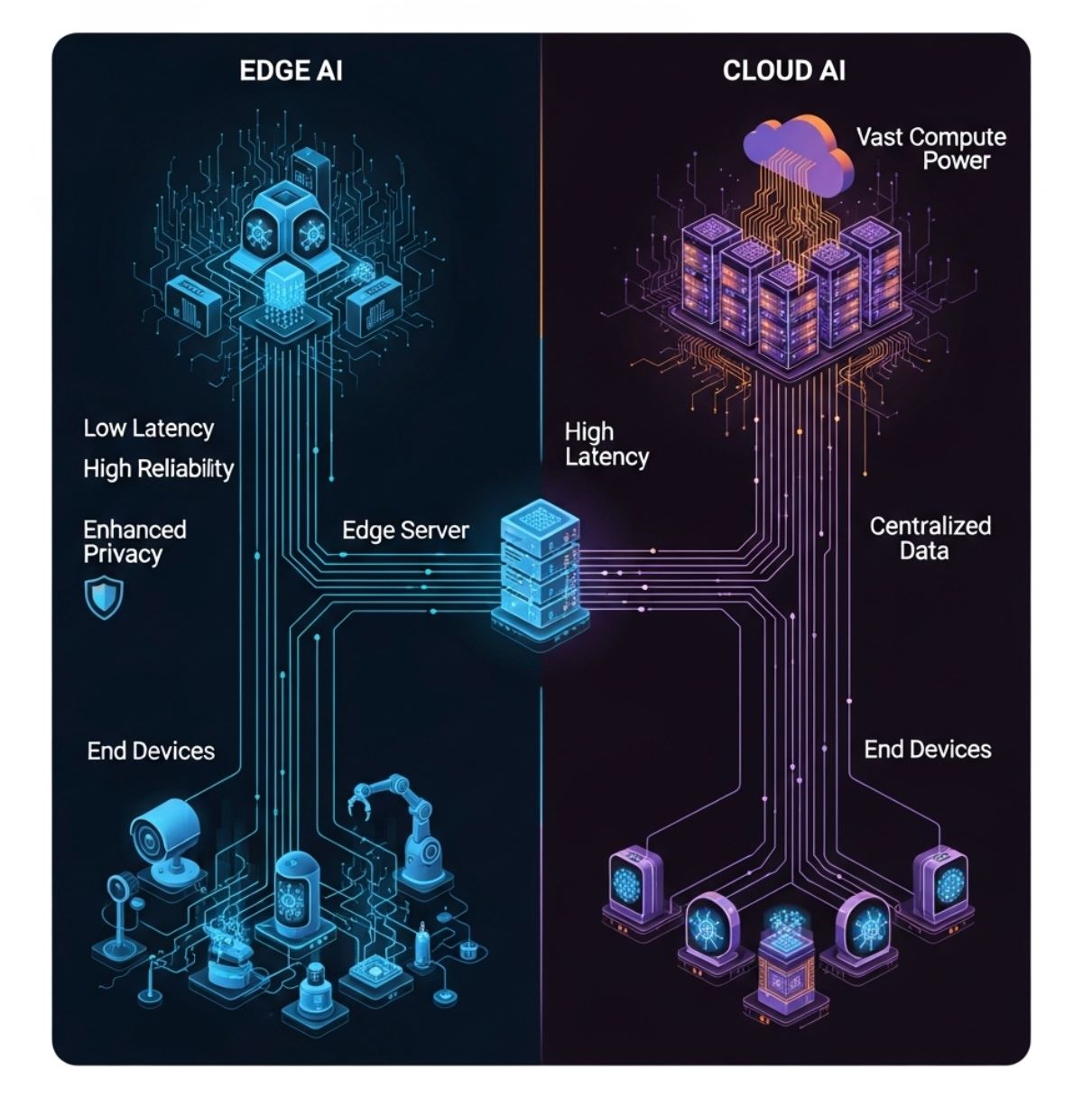
Benefits of Edge AI
Edge AI offers several practical advantages for users and organizations:
- Real-time responsiveness: Processing data locally enables immediate analysis. Users get instant feedback (e.g. live object detection, voice reply, anomaly alert) without waiting for a round-trip to the cloud.
This low latency is a major benefit for applications like augmented reality, autonomous vehicles, and robotics. - Reduced bandwidth and cost: With Edge AI, only summarized results or unusual events need to be sent over the internet. This slashes data transfer and cloud storage costs.
For instance, a security camera might only upload clips when it detects a potential threat, rather than streaming continuously. - Enhanced privacy: Keeping data on-device improves security. Personal or sensitive information never leaves the local hardware if processed at the edge.
This is especially important for applications under strict privacy rules (healthcare, finance, etc.), since Edge AI can keep data within a country or facility. - Energy and cost efficiency: On-device AI can save power. Running a tiny model on a low-power chip often uses less energy than sending data to a cloud server and back.
It also reduces server costs – large AI workloads are expensive to host in the cloud. - Offline capability and resilience: Edge AI can continue working if connectivity fails. Devices can still function with local intelligence, then sync later.
This makes systems more robust, especially in remote areas or in mission-critical uses (e.g. industrial monitoring).
Red Hat and IBM both highlight these perks. Edge AI “brings high-performance computing capabilities to the edge,” enabling real-time analysis and improved efficiency.
As one report summarizes, edge deployments drive down latency and bandwidth needs while boosting privacy and reliability.
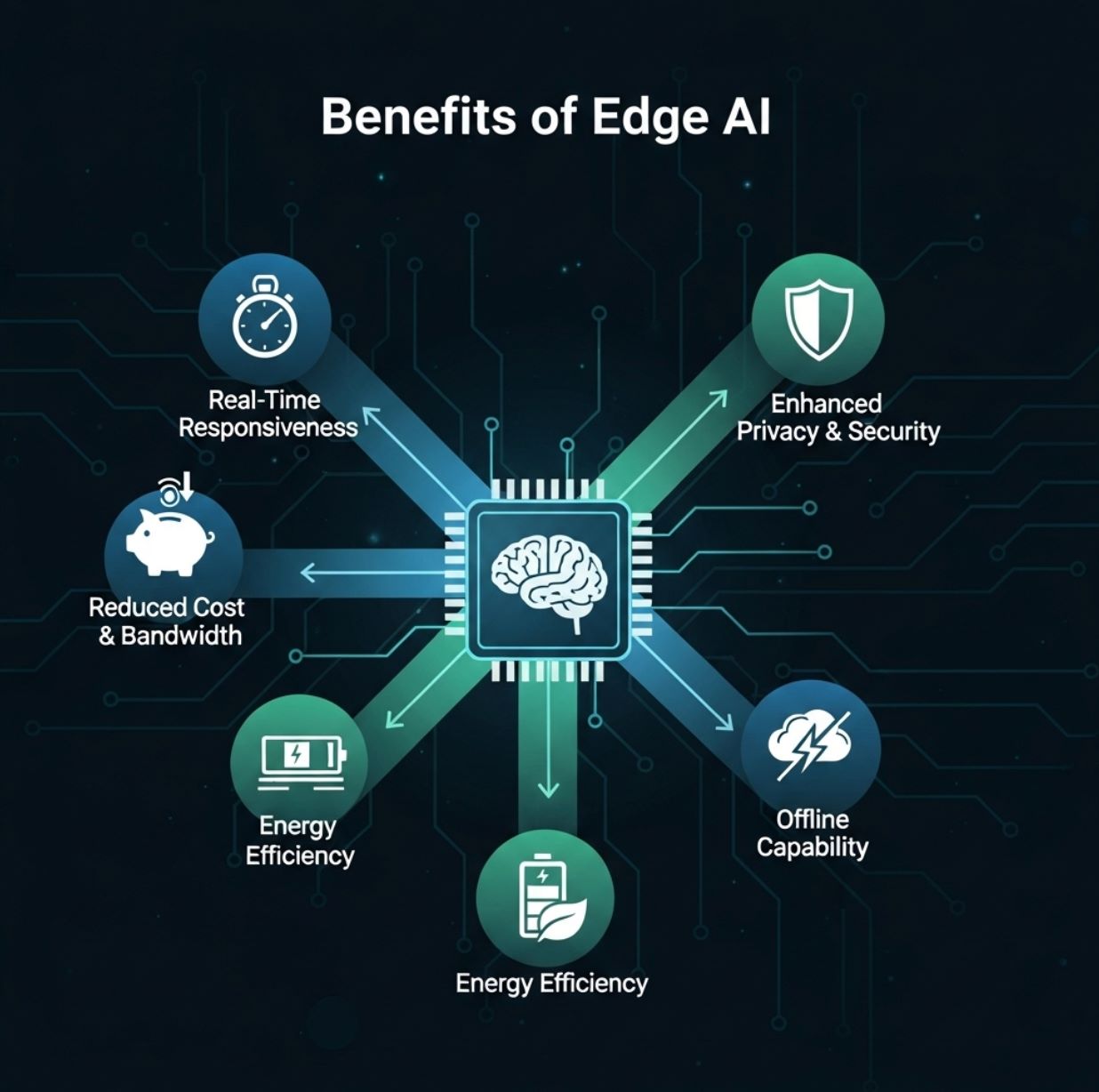
Challenges of Edge AI
Despite its advantages, Edge AI also faces hurdles:
- Hardware limitations: Edge devices are typically small and resource-constrained. They may only have modest CPUs or specialized low-power NPUs, and limited memory.
This forces AI engineers to use model compression, pruning or TinyML techniques to fit models on the device. Complex deep learning models often cannot run full-scale on a microcontroller, so some accuracy may be sacrificed. - Model training and updates: Training sophisticated AI models usually still happens in the cloud, where massive data and computing power are available. After training, those models must be optimized (quantized, pruned, etc.) and deployed to each edge device.
Keeping thousands or millions of devices up-to-date can be complex. Firmware and data synchronization add management overhead. - Data gravity and heterogeneity: Edge environments are diverse. Different locations may collect different types of data (sensors vary by application), and policies may vary by region.
Integrating and standardizing all that data is challenging. As IBM notes, deploying edge AI widely raises issues of “data gravity, heterogeneity, scale and resource constraints”. In other words, data tends to stay local, making it hard to gather a global view, and devices come in all shapes and sizes. - Security at the edge: While Edge AI can improve privacy, it also introduces new security concerns. Each device or node is a potential target for hackers.
Ensuring that local models are tamper-proof and that firmware is secure requires strong safeguards. - Dependence on connectivity for some tasks: Although inference can be local, edge systems still often rely on cloud connectivity for heavy tasks like retraining models, large-scale data analysis, or aggregating distributed results.
Limited connectivity can bottleneck these back-office functions.
In practice, most solutions use a hybrid model: edge devices handle inference, while the cloud handles training, model management and big-data analytics.
This balance helps overcome resource constraints and allows edge AI to scale.

Use Cases of Edge AI
Edge AI is being applied across many industries. Real-world examples include:
- Autonomous vehicles: Self-driving cars use on-board Edge AI to instantly process camera and radar data for navigation and obstacle avoidance.
They can’t afford the delay of sending video to a server, so everything (object detection, pedestrian recognition, lane tracking) happens locally. - Manufacturing and Industry 4.0: Factories deploy smart cameras and sensors on production lines to detect defects or anomalies in real time.
For example, an Edge AI camera can spot a faulty product on the conveyor and trigger immediate action. Similarly, industrial machines use on-site AI to predict equipment failures (predictive maintenance) before breakdowns occur. - Healthcare and Emergency Response: Portable medical devices and ambulances now use Edge AI to analyze patient data on the spot.
An ambulance’s onboard ultrasound or vital-sign monitor can apply AI instantly to detect internal injuries or alert paramedics about abnormal vitals. In hospitals, Edge AI can continuously monitor ICU patients and trigger alarms without waiting for a central server. - Smart Cities: Urban systems use edge AI for traffic management, surveillance, and environmental sensing.
Smart traffic lights adjust timing using local AI that analyzes camera feeds, easing congestion in real time. Street cameras can detect incidents (accidents, fires) and alert authorities immediately. By keeping processing local, cities can react quickly without overloading central networks. - Retail and Consumer IoT: Edge AI enhances customer experience and convenience.
In stores, smart cameras or shelf sensors use AI to track shopper behavior and inventory levels instantly. At home, smartphones, tablets and smart speakers run voice or face recognition on the device. For example, a smartphone can unlock or identify gestures without cloud access. Fitness trackers analyze health data (heart rate, steps) locally to give real-time feedback.
Other emerging uses include precision agriculture (drones and sensors using Edge AI to monitor soil and crop health) and security systems (on-device face recognition for locks). As one IEEE study notes, Edge AI is crucial for applications like smart farming, traffic control, and industrial automation.
In short, any scenario that benefits from instant, local analysis is a strong candidate for edge AI.
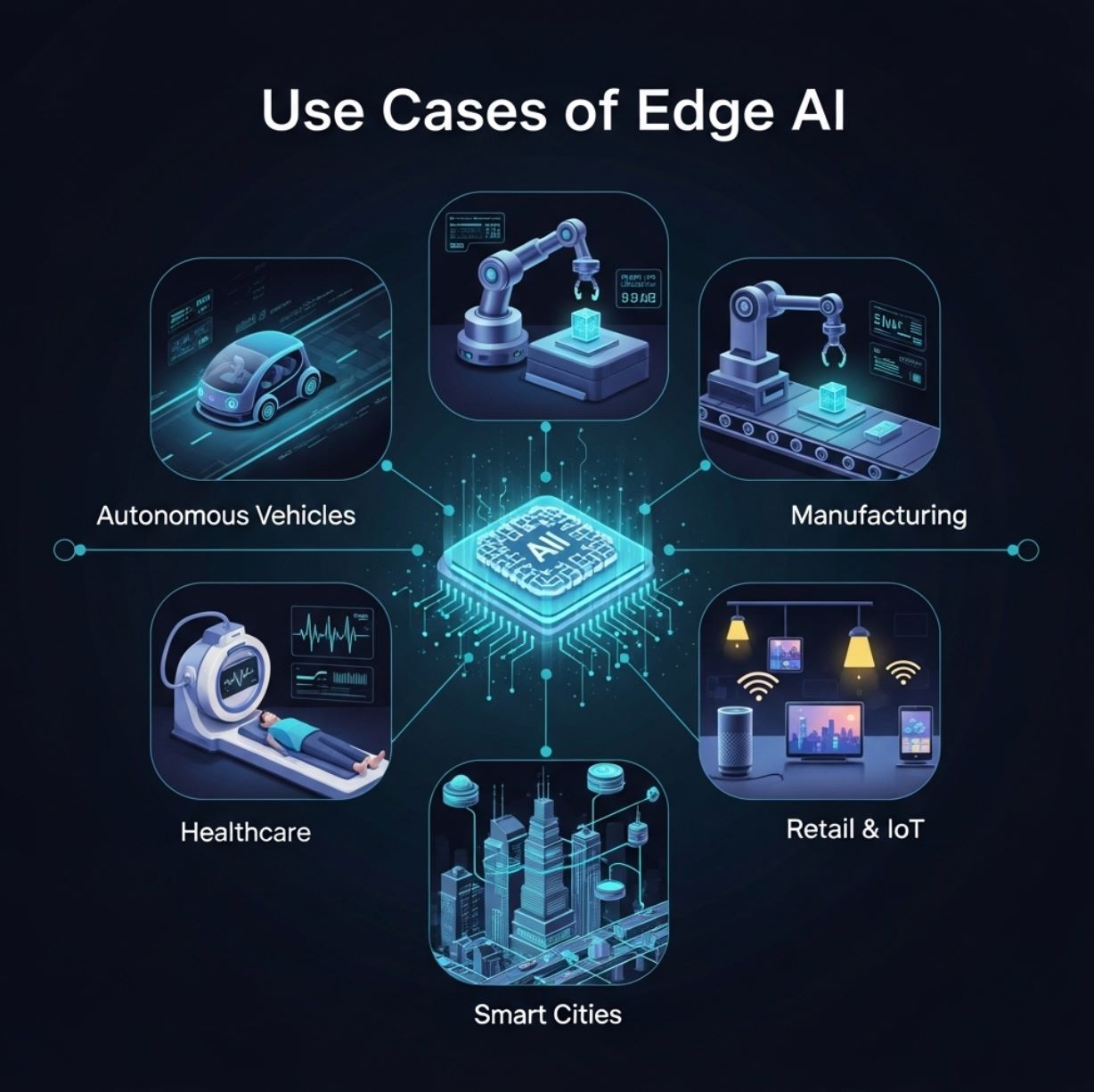
Enabling Technologies and Trends
The growth of Edge AI is fueled by advances in both hardware and software:
- Specialized hardware: Manufacturers are building chips designed for edge inference. These include low-power neural accelerators in smartphones (NPUs) and dedicated edge AI modules like Google Coral Edge TPU, NVIDIA Jetson Nano, and low-cost microcontroller boards (Arduino, Raspberry Pi with AI add-ons).
A recent industry report notes that progress in ultra-low-power processors and “edge-native” algorithms is overcoming the limits of device hardware. - TinyML and model optimization: Tools like TensorFlow Lite and techniques such as model pruning, quantization and distillation make it possible to shrink neural networks to fit on tiny devices.
“TinyML” is an emerging field focused on running ML on microcontrollers. These approaches extend AI to sensors and wearables that run on batteries. - 5G and connectivity: Next-generation wireless (5G and beyond) provides high bandwidth and low-latency links that complement Edge AI.
Fast local networks make it easier to coordinate clusters of edge devices and offload heavier tasks when needed. This synergy between 5G and AI enables new applications (e.g. smart factories, vehicle-to-everything communication). - Federated and collaborative learning: Privacy-preserving methods like federated learning allow multiple edge devices to jointly train a model without sharing raw data.
Each device improves the model locally and only shares updates. This trend (hinted at in future tech roadmaps) will enhance Edge AI by leveraging distributed data while keeping it private. - Emerging paradigms: Looking forward, research is exploring neuromorphic computing and on-device generative AI to further boost edge intelligence.
As one report predicts, innovations such as brain-inspired chips and local large-language models could appear at the edge.
These technologies continue to push the boundary of what Edge AI can do. Together, they help deliver the “AI inference era” – shifting intelligence closer to users and sensors.
>>> You may be interested:
What is Reinforcement Learning?
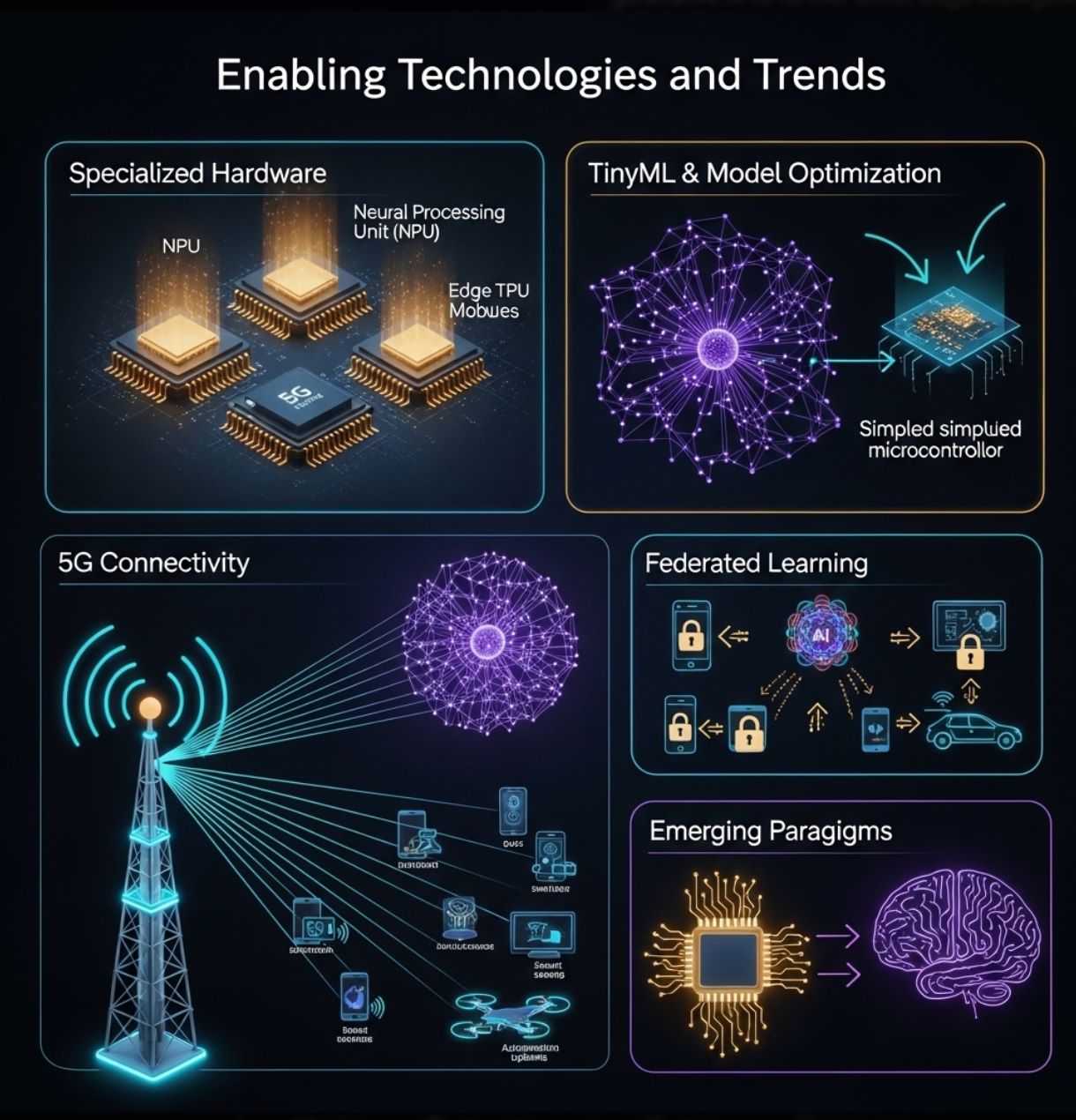
Edge AI is transforming how we use artificial intelligence by moving computation to the data source. It complements cloud AI, delivering faster, more efficient, and more private analytics on local devices.
This approach addresses real-time and bandwidth challenges inherent in cloud-centric architectures. In practice, Edge AI powers a wide range of modern technologies – from smart sensors and factories to drones and self-driving cars – by enabling on-the-spot intelligence.
As IoT devices proliferate and networks improve, Edge AI is only set to grow. Advances in hardware (powerful microchips, TinyML) and techniques (federated learning, model optimization) are making it easier to put AI everywhere.
According to experts, Edge AI brings notable gains in efficiency, privacy, and bandwidth use. In short, Edge AI is the future of embedded intelligence – offering the best of AI in a distributed, on-device form.


